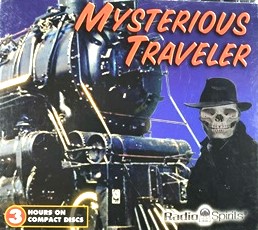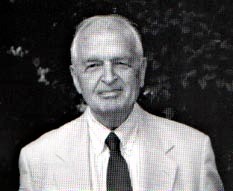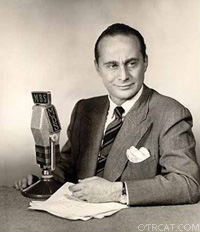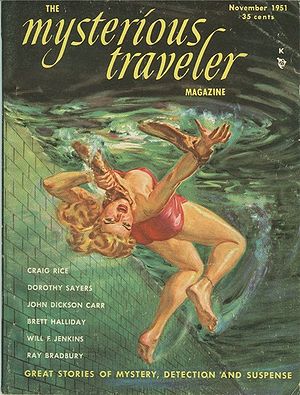
 The Mysterious Traveler (1943-1952) aired “Fire in the Sky” on August 28, 1951 as the 319th of its estimated 384 broadcasts, of which 303 were original scripts. Only 75-80 are known to be in circulation at the present time. Since our first double-episode airing of the show in 2009 we have showcased 15 episodes, this being the first since November of 2021, well over 2 years ago. Thus, a recap of our original introductory notes (with minor edits) are in order for newcomers, for they form a fascinating picture of the show and the men who created it.
The Mysterious Traveler (1943-1952) aired “Fire in the Sky” on August 28, 1951 as the 319th of its estimated 384 broadcasts, of which 303 were original scripts. Only 75-80 are known to be in circulation at the present time. Since our first double-episode airing of the show in 2009 we have showcased 15 episodes, this being the first since November of 2021, well over 2 years ago. Thus, a recap of our original introductory notes (with minor edits) are in order for newcomers, for they form a fascinating picture of the show and the men who created it.
The Mysterious Traveler aired on the Mutual Broadcasting Network for almost nine years (Dec. 5, 1943–Sept. 16, 1952) and, oddly enough, never had a sponsor. It ran the gamut from science-fiction, fantasy, and horror, to mystery and suspense. Each episode began with the sound of an approaching train, inside of which an unnamed passenger would narrate the story between stops. The shows were written by Robert Arthur (1909-1969, photo at lower right, typing) and David P. Kogan (born 1916 and still wonderfully alive*–-photo top right), were produced and directed by Kogan, and were hosted/narrated by Maurice Tarplin (1911-1975, pictured below), whose tantalizing, yet calmly underplayed introductions would be readily recognized on many another old time radio show. Kogan and Arthur also created, wrote, produced, and directed another well-received show (Edgar Award winner, 1950, for Best Radio Drama), Murder by Experts (1949-51), featuring such mystery luminaries as John Dickson Carr and Brett Halliday as hosts. As well, Kogan and Arthur did contract writing for episodes of The Shadow and Bulldog Drummond.
 Maurice Tarplin could also be heard as the radio voice of Dr. Weird on The Strange Dr. Weird radio show (1944-1945, a rather short-lived knock-off of The Mysterious Traveler, and also written by Robert Arthur; most shows being shortened, 15-minute versions of TMT scripts), and numerous other radio shows, including The Shadow. Tarplin’s only novel, Seven Circles of Death, was published in the June, 1948 issue of Dime Mystery Magazine. Tarplin was a well-liked and much respected figure in old time radio.
Maurice Tarplin could also be heard as the radio voice of Dr. Weird on The Strange Dr. Weird radio show (1944-1945, a rather short-lived knock-off of The Mysterious Traveler, and also written by Robert Arthur; most shows being shortened, 15-minute versions of TMT scripts), and numerous other radio shows, including The Shadow. Tarplin’s only novel, Seven Circles of Death, was published in the June, 1948 issue of Dime Mystery Magazine. Tarplin was a well-liked and much respected figure in old time radio.
Robert Arthur, before his long-running, pressure-cooker, weekly scripting duties at The Mysterious Traveler, wrote many stories for the genre magazines. Between 1930 and 1940 he was published in Wonder Stories, Weird Tales, Amazing Stories, Startling Stories, Unknown Worlds, and in several of Street & Smith’s mystery and detective magazines. In 1958, Dodd, Mead, & Co. issued a collection of classic reprint stories titled Deals with the Devil. It was edited by Basil Davenport and included the Robert Arthur story “Satan and Sam Shay” from a 1942 issue of Elks Magazine. Arthur was in good company in this collection, for it featured stories by, among others, Henry Kuttner, Anthony Boucher, and John Collier. Arthur’s story (in the paperback edition I own) is sandwiched between tales by none other than Lord Dunsany and Arthur Porges. (An abridged paperback edition of this collection was issued in 1969 under Ballantine’s “Bali-Hi” imprint. While some stories were cut, the Robert Arthur story remains.) Later in his career Arthur wrote scripts for the original The Twilight Zone and worked as a story editor and script writer for the Alfred Hitchcock television show Alfred Hitchcock Presents. Arthur also ghost-edited many of the Alfred Hitchcock-credited collections of mystery or horror stories (many for the YA audience), as well as ghosting other projects which would appear under the Hitchcock name.
Between 1930 and 1940 he was published in Wonder Stories, Weird Tales, Amazing Stories, Startling Stories, Unknown Worlds, and in several of Street & Smith’s mystery and detective magazines. In 1958, Dodd, Mead, & Co. issued a collection of classic reprint stories titled Deals with the Devil. It was edited by Basil Davenport and included the Robert Arthur story “Satan and Sam Shay” from a 1942 issue of Elks Magazine. Arthur was in good company in this collection, for it featured stories by, among others, Henry Kuttner, Anthony Boucher, and John Collier. Arthur’s story (in the paperback edition I own) is sandwiched between tales by none other than Lord Dunsany and Arthur Porges. (An abridged paperback edition of this collection was issued in 1969 under Ballantine’s “Bali-Hi” imprint. While some stories were cut, the Robert Arthur story remains.) Later in his career Arthur wrote scripts for the original The Twilight Zone and worked as a story editor and script writer for the Alfred Hitchcock television show Alfred Hitchcock Presents. Arthur also ghost-edited many of the Alfred Hitchcock-credited collections of mystery or horror stories (many for the YA audience), as well as ghosting other projects which would appear under the Hitchcock name.
 Near the end of The Mysterious Traveler‘s long and popular run, Arthur and Kogan decided to branch out, publishing The Mysterious Traveler magazine. Kogan was the publisher and Arthur the managing editor. It ran for only five issues, from November 1951, to September 1952, but what a run it was. Along with printing quite a number of his own stories, Robert Arthur would select stories from (among others) John Dickson Carr, Dorothy Sayers, Brett Halliday, Agatha Christie, William Hope Hodgson, and Ray Bradbury. Bradbury’s “The Wind” saw print in the first issue (cover at left) and would be collected in his 1955 book The October Country. Bradbury’s “To the Future” ran in issue #2, July 1952, and his “The Crowd” would see print in the final issue, September 1952. The cover art for the magazine was spectacular, all five issues graced by the work of the incomparable Norman B. Saunders, whose art would bring to vibrant life hundreds of pulp covers of the time and whose work is now eagerly sought by art collectors.
Near the end of The Mysterious Traveler‘s long and popular run, Arthur and Kogan decided to branch out, publishing The Mysterious Traveler magazine. Kogan was the publisher and Arthur the managing editor. It ran for only five issues, from November 1951, to September 1952, but what a run it was. Along with printing quite a number of his own stories, Robert Arthur would select stories from (among others) John Dickson Carr, Dorothy Sayers, Brett Halliday, Agatha Christie, William Hope Hodgson, and Ray Bradbury. Bradbury’s “The Wind” saw print in the first issue (cover at left) and would be collected in his 1955 book The October Country. Bradbury’s “To the Future” ran in issue #2, July 1952, and his “The Crowd” would see print in the final issue, September 1952. The cover art for the magazine was spectacular, all five issues graced by the work of the incomparable Norman B. Saunders, whose art would bring to vibrant life hundreds of pulp covers of the time and whose work is now eagerly sought by art collectors.
Perhaps the most interesting back story, however, behind the The Mysterious Traveler radio show, aside from those of its talented pair of writers, producer/director, host, and then magazine, is the tragic story of its unexpected demise in the autumn of 1952, while it remained as popular and well-received as ever, and must be judged as one of the most unusual cancellations in all of radio history. 1952 saw the United States and the Soviet Union in the midst of the Cold War following the end of World War II in 1945. Senator Joseph P. McCarthy had been stirring up anti-communist sentiment here at home since 1950, when, unable to garner support for his political aspirations from the Democratic party, he became a Republican. Solely for personal political gain, and at the direct urgings of investigative reporter, journalist, and newspaper man Jack Anderson–-and then with the aid of FBI director J. Edgar Hoover, he sought to bring down democrats by smearing them either as communists, communist sympathizers, or as being soft on communism (one of whom he accused of being such, in 1950, was President Harry S. Truman; never mind that in the third week of June 1950, after the UN condemnation of the Chinese Communist-backed North Korean invasion of South Korea, Truman gave General Douglas MacArthur the authority to defend South Korea from the Communist incursion). Among the many casualties of McCarthy’s politically-motivated communist witch-hunt were Robert Arthur and David Kogan. Both were members of the Radio Writer’s Guild, which, of course, many in the radio business were at the time (both Republican and Democrat). With dubious “evidence” at best, the House Un-American Activities Committee (HUAC) vaguely “determined” that the Radio Guild was “a Communist front organization.” Whereupon the Mutual Broadcasting Network and WOR, the New York flagship station of The Mysterious Traveler, caved under the perceived fallout of the ruling and cancelled the long-running program in early 1953 prior to its next season. Coincidence or not, both the radio and magazine incarnations of The Mysterious Traveler died in September of 1952.
Nevertheless, The Mysterious Traveler, via the talents of Robert Arthur, David Kogan, and Maurice Tarplin gave their radio listening audience a good enough ride over time, with something in its diverse approach to subject matter, to keep their faithful audience returning week after week for nine years, and with many a suspense-laden chill and thrill along the way. More’s the pity the show ended as it did. Of the show’s 370 episodes, only 75-80 are known to still exist. The Mysterious Traveler won three Edgar Awards for Best Radio Drama; in 1949, 1951, and 1953.
“Fire in the Sky” begins benignly with the Ramsey’s, a newlywed couple en route to their honeymoon destination, listening to the car radio as the announcer updates what is known about the comet streaking across the sky, the stellar object holding the whole world’s attention. Tension begins to mount when they are stopped by an old man supposedly in need of help but who quickly turns out not to be what he seems. He forcibly takes them hostage at gun point after reaching an old, abandoned coal mine descending some 1,000 feet below the surface, for a specific reason he soon makes clear to them. At this point I shall reveal no more except to say that I have chosen this episode not for its superior storyline but as a perfect example of a theme foremost on the minds of Americans in the early 1950s, that of the Atomic Age and the fears it brought to bear on our country and its safety following WWII. The gist of this dramatization is not new to us now, more than 75 years after the atomic bombs dropped on Japanese cities ended WWII in the Pacific. It is in fact a rather tired cliché, though it was very real to those adjusting to the threat of worldwide annihilation by nuclear holocaust and the attendant nuclear fallout that would conceivably lay waste our planet for many decades to come, if not forever. Such was the state of knowledge about the effects of nuclear war, and this early, less complete understanding is evidenced here in several places. But the fact remains that this episode deals with one of the major themes confronting not only America but the entire world as we attempted to deal with what we might be facing in the new, uncharted Atomic Age. There were no trustworthy signposts ahead, so we had to attempt to examine and explore both the positive and negative futures that lay beyond the next curve in the newly paved atomic superhighway. Try to place yourself in the position of the newlywed couple at the center of this week’s story, with their entire lives and future ahead of them, as they are forced to come to grips with the strange story told by a forgotten old man who warns them of the true danger from the “Fire in the Sky.”
Play Time: 29:10
*{Editor’s Note: Shortly following Tangent Online‘s presentation of The Mysterious Traveler episodes “The Good Die Young” and “Till Death Do Us Part” on June 19, 2009, I received the following email from none other than David P. Kogan, co-writer, and producer/director of the show. It seems the information I gathered from several online sources was in error as to his date of birth, and had listed him as being deceased. That error has now been corrected. Mr. Kogan writes:
“As a first time viewer of Tangent, I was surprised to find that I had died in 1964. This means I have been living forty-five years on borrowed time. I begin to see a script shaping up…On whose borrowed time have I been living? While you have Bob Arthur’s dates right, for your information I was born in 1916… and continue to breathe. For how long… is the question. David Kogan”
Though embarrassed by my research error, I was nevertheless thrilled to receive a letter from David Kogan, who, in his early 90s, somehow discovered Tangent Online and had taken the time to write (even if it was to correct an error). I received his email on July 17, 2009.
Sadly, I received an email from Mr. Kogan’s son Kenneth on August 10th, informing me of the death of his father on August 6, 2009, a mere three weeks following his email to us. A startlingly talented man, David Kogan (1916-2009) will be sorely missed.}
To view the entire list of Old Time Radio episodes at Tangent Online, go here.